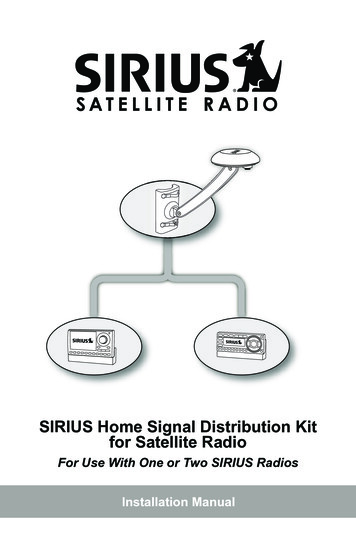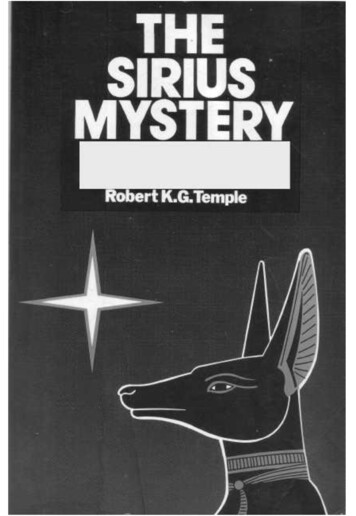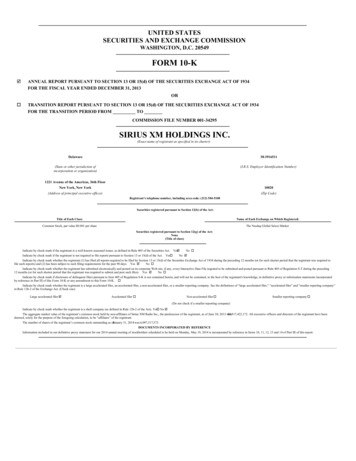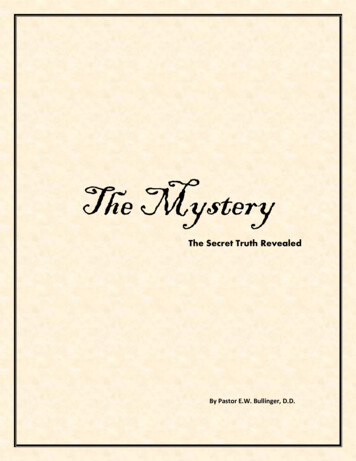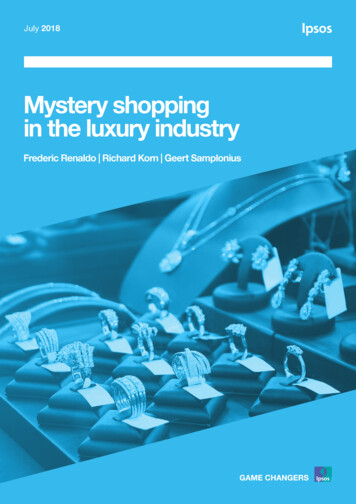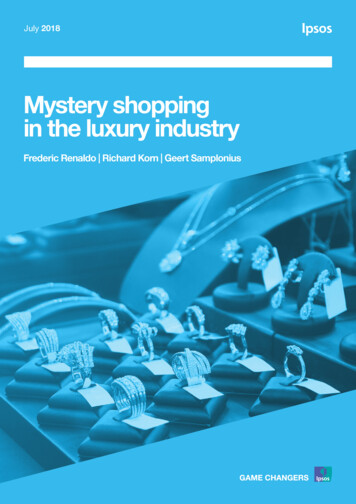
Transcription
INVESTIGATING THE SIRIUS"MYSTERY"Ian RidpathDid amphibious beings from the star Sirius visit the earth 5,000 or moreyears ago and leave advanced astronomical knowledge that is still possessed by a remote African tribe called the Dogon? This astonishingclaim was put forward in 1976 by Robert Temple in his "ancient astronaut" book, The Sirius Mystery. An astronomer, familiar with the Siriussystem, would say no, because astronomical theory virtually precludesthe possibility that Sirius is a suitable parent star for life or that it couldhave habitable planets. But most of Robert Temple's readers would notknow enough astronomy to judge the matter for themselves. Neitherwould they find the relevant astronomical information in Temple'sbook, most of which consists of brain-numbing excursions into Egyptology. (Isaac Asimov has been quoted by Temple as having said that hefound no mistakes in the book; but Temple did not know that the reasonfor this, according to Asimov, was that he had found the book too impenetrable to read!*) Even the BBC-TV Horizon investigation on ancient astronauts (broadcast as part of the PBS "Nova" series in theUnited States), which did an otherwise excellent demolition job on themore extreme fantasies of Erich von Daniken, left the Sirius problemunanswered because of its extreme complexity. Yet an answer is needed,because the Dogon legends about a companion to Sirius are claimed tooriginate before any terrestrial astronomer could have known of the existence of Sirius B, let alone its 50-year orbit or its nature as a tiny, con* Editor's note: See Asimov's essay, "The Dark Companion," in his Quasar, QuasarBurning Bright (Doubleday, 1978), in which he says he is embarrassed by his stupidity innot specifying that his comment, made only "to get rid of him [Temple] and to be polite,"not be quoted. "I assure you I will never be caught that way again."—K.F.56T H E SKEPTICAL INQUIRER
densed white dwarf star, all of which the Dogon allegedly knew. So whatis the truth about the Dogon and Sirius? Does astronomical and anthropological information omitted by Temple help us to resolve this mostbaffling of all ancient astronaut cases?First, let's recap Temple's story. At the center of the mystery are theDogon people living near Bandiagara, about 300 kilometers south ofTimbuktu, Mali, in western Africa. Knowledge of their customs andbeliefs comes from the French anthropologists Marcel Griaule and Germaine Dieterlen, who worked among the Dogon from 1931 to 1952. Between 1946 and 1950 the Dogon head tribesmen unfolded to Griaule andDieterlen the innermost secrets of their knowledge of astronomy. Muchof this secret lore is complex and obscure, as befits ancient legends, butcertain specific facts stand out, particularly those concerning the starSirius, with which their religion and culture is deeply concerned. In theinformation imparted to the French anthropologists, the Dogon referredto a small and super-dense companion of Sirius, made of matter heavierthan anything on Earth, and moving in a 50-year elliptical orbit aroundits parent star. The white dwarf companion of Sirius which answers tothis description was not seen until 1862, when the American opticianAlvan Graham Clark spotted it while testing a new telescope; the superdense nature of white dwarfs was not realized until the 1920s. But theDogon Sirius traditions are at least centuries old. How can we accountfor the remarkable accord between ancient Dogon legends and modernastronomical fact?Temple's answer, since espoused by Erich von Daniken (of course!),was that the Dogon were told by extraterrestrial visitors. A Dogonlegend, similar to many other tales by primitive people of visits from thesky, speaks of an "ark" descending to the ground amid a great wind.Robert Temple interprets this as the landing of a rocket-poweredspacecraft bringing beings from the star Sirius. According to Dogonlegend, the descent of the ark brought to Earth an amphibious being, orgroup of beings, known as the Nommo. "Nommo is the collective namefor the great culture-hero and founder of civilization who came from theSirius system to set up society on the Earth," Temple explains in hisbook. The Nommo were amphibious, he presumes, because water wouldkeep them cool and absorb short-wavelength radiation from the hot starSirius.Much of Temple's book is devoted to establishing that the Dogonshare common roots with Mediterranean peoples. This explains the cen-Fall 197857
tral place occupied by Sirius in Dogon beliefs, because the ancient Egyptians, in particular, were also preoccupied with Sirius, basing their calendar on its yearly motion. But is there any explanation of the apparentDogon belief in life in the Sirius system?First, let's look at what astronomers know about Sirius to see if it isat least theoretically plausible that advanced life might have arisen in itsvicinity. Sirius A, the brightest star in the night sky as seen from Earth,has a mass 2.35 times that of the sun. Its white dwarf companion, SiriusB, has a mass of 0.99 suns. Stellar evolutionary theory tells us that themost massive stars burn out the quickest, so that originally Sirius B musthave been the more massive of the two, before burning out to become awhite dwarf. Probably Sirius B spilled over some of its gas onto Sirius Aduring its aging process, so that the original masses of the two stars wereapproximately the reverse of what we see today.A star with twice the sun's mass, as Sirius B probably had, can livefor no more than about 1,000 million years before swelling up into a redgiant; this does not seem long enough for advanced life to develop. Buthad life evolved, it would have disappeared during the red giant stageof Sirius B, when any nearby planet would have been roasted by thestar's increased energy output, followed by a stellar gale for at least100,000 years as hot gas streamed from Sirius B to Sirius A. Duringthis mass transfer the two stars would have moved apart, thereby destabilizing the orbits of any planets in the system. According to observationsof Sirius B as analyzed by H. L. Shipman of the University of Delaware,Sirius B has been a cooling-down white dwarf for at least 30 millionyears. Sirius B is now emitting soft x-rays, so that life in the region ofSirius would not be very pleasant today. But in any case, Robert S. Harrington of the U.S. Naval Observatory has recently shown that planetaryorbits in the "habitable" zone around Sirius, defined as the region inwhich water would be liquid, are unstable. So there are unlikely to be anyamphibious beings living on planets in the Sirius system today, if indeedany such beings ever lived there.Temple offers one prediction which allows a test of his theory. In hisbook he says: "What if this is proven by our detecting on our radiotelescopes actual traces of local radio communications?" To help in myinvestigation of the Sirius mystery, I asked radio astronomers PaulFeldman at the Algonquin radio observatory, Canada, and Robert S.Dixon at the Ohio State University radio observatory, both of whom arecarrying out searches for extraterrestrial signals, to listen to Sirius. They58T H E SKEPTICAL INQUIRER
would normally have paid the star no attention, because of the extremeunlikelihood of its supporting life. In April 1977 both radio astronomerslistened to Sirius on different wavelengths, without detecting any artificial signals.With this information in mind, let's look more skeptically at theDogon legend. Immediately, we encounter a surprise: the Dogon maintain that Sirius has two companions, not one. These companions havemale and female attributes, respectively. It seems that they are not to beinterpreted literally as stars, but as fertility symbols. Nowhere is this better shown than in a Dogon sand diagram of the complete Sirius system,shown in the illustration redrawn here from a paper by Griaule andDieterlen. Its description, given in the caption from information byGriaule and Dieterlen, is clearly symbolic; Temple chooses to interpret itliterally. On pages 23 and 25 of his book he gives his own modified version of this diagram, retaining the symbol for Sirius, one of the positionsof Sirius B, and the surrounding oval; all else is omitted. He then interprets the surrounding oval meant to represent "the egg of the world," asthe elliptical orbit of Sirius B around Sirius A, even though the symbolequated with Sirius B is drawn as lying within the oval, not on it. This isTemple's basis for saying that the Dogon "know" Sirius B orbits SiriusA in an ellipse.The Dogon are also supposed to know that Sirius B orbits every 50years. But what do they actually say? Griaule and Dieterlen put it asfollows: "The period of the orbit is counted double, that is, one hundredyears, because the Siguis are convened in pairs of 'twins,' so as to insiston the basic principle of twinness." The Sigui ceremony referred to is aceremony of the renovation of the world that is celebrated every 60 years(not 50). And the "twinness" referred to here is an important Dogonconcept which explains why they believe Sirius must have two companions.Is there any astronomical evidence that Sirius has more than onecompanion star? Some astronomers in the 1920s and 1930s thought theyhad glimpsed a third member of the Sirius system, but new and more accurate observations reported in 1973 by Irving W. Lindenblad of theU.S. Naval Observatory, Washington, D.C., showed no evidence of aclose companion to either Sirius A or Sirius B.The whole Dogon legend of Sirius and its companions is riddledwith ambiguities, contradictions, and downright errors, at least if we tryto interpret it literally. But what can we make of the Dogon statementFall 197859
Dogon sand drawing of the complete Sirius system, after Marcel Griaule and GermaineDieterlen. A, Sirius; B, po tolo, the object equated with Sirius B, shown in two positions;C, emmeya, the sun of women, equated with Sirius C; D, the Nommo; E, the Yourougou,a mythical male figure destined to pursue his female twin; F, the star of women, a satelliteof emma ya\ G, the sign of women; H, the sex of women, represented by a womb shape.The whole system is enclosed in an oval, representing the egg of the world.60T H E SKEPTICAL INQUIRER
that Sirius B is the smallest and heaviest star, consisting of a heavy metalknown as sagalal Sirius B was certainly the smallest and heaviest starknown in the 1920s, when the super-dense nature of white dwarfs wasbecoming understood; the material of which white dwarfs are made is indeed compressed more densely than metal. Now, though, hundreds ofwhite dwarfs are known, not to mention neutron stars, which are farsmaller and denser. Any visiting spaceman would certainly have knownabout these, as well as black holes.Perhaps one would forgive Robert Temple for believing that theDogon had been visited by men from Sirius if their legend specificallystated so. But it does not! Nowhere in his 290-page book does Templeoffer one specific statement from the Dogon to substantiate his ancientastronauts claim. The best he does is on page 217, where he reports thatthe Dogon say: "Po tolo [Sirius B] and Sirius were once where the Sunnow is." Of this ambiguous statement, Temple comments: "That seemsas good a way as any. to describe coming to our solar system from theSirius system, and leaving those stars for our star, the Sun." But thiscannot conceal the fact that the whole Sirius "mystery" is based onTemple's own unwarranted assumption.The parts of Dogon knowledge that are admittedly both ancient andprofound, particularly the story of Nommo and the concept of twinning,are the parts that bear least relation to the true facts about Sirius. Theparts that bear at least superficial resemblance to astronomical fact aremost likely trimmings added in this century. Indeed, in view of theDogon fixation with Sirius it would surely be more surprising if they hadnot grafted on to their existing legend some new astronomical information gained from Europeans, picking what fitted their purpose and ignoring the rest.Carl Sagan has underlined how easily information gained fromWesterners can be absorbed into native culture. He recounts the true caseof the physician Carleton Gajdusek in New Guinea, who was approachedby a scientific colleague who had found that some local natives believedthat a certain disease was transmitted in the form of an invisible spiritthat entered the skin of a patient. The native informant had sketchedwith a stick in the sand a circle outside which, he explained, was black,and inside which was light. Within the circle the informant drew a squiggly line to represent the appearance of these invisible malevolent spirits.How did the natives get such an astounding insight into the transmissionof disease by microbes? Years earlier, Gajdusek himself had shown theFall 197861
natives the appearance of a disease-causing germ through his microscope, and the sand drawing was simply the natives' recollection of thisdeeply impressive sight.It is all too easy for Westerners to think of African tribes as isolated,uneducated, and ignorant. But the Dogon are not isolated. They live nearan overland trade route, as well as close to the banks of the Niger River,an important channel of trade. Any number of travelers could have comeinto their midst, or Dogon tribesmen could have journeyed to the coast,where they might have met astronomically informed seamen. The Dogonhave been in contact with Europeans since at least the late nineteenthcentury.Nor are they uneducated and ignorant. Peter and Roland Pesch ofthe Warner and Swasey Observatory in Ohio have pointed out thatFrench schools have existed in the Dogon area since 1907. Dogontribesmen wishing to pursue their education have been able to do so innearby towns. Then there are missionaries, who would naturally be interested in the legends of the natives. Missionaries from the WhiteFathers made contact with the Dogon in the 1920s. It is tempting to speculate that certain of the more specific details about Sirius B were graftedonto the existing Sirius legend at that time, because it was in the 1920sthat astronomers were discovering the true nature of Sirius B as a tiny,super-dense star, and white dwarfs were being accorded the same kind ofpublicity as attends black holes today. Alas, there is no mention in themissionaries' summary reports of their activities that they discussedSirius with the Dogon; if more detailed notes were published, these mightthrow more light on the origin and antiquity of Dogon myths.The point is that there are any number of channels by which theDogon could have received Western knowledge long before they werevisited by Griaule and Dieterlen. We may never be able to reconstruct theexact route by which the Dogon received their current knowledge, butout of the confusion at least one thing is clear: they were not told by beings from the star Sirius.ReferencesHarrington, R. S. 1977. Astronomical Journal, 82: 753.Lindenblad, I. W. 1973. Astronomical Journal, 78: 205.Pesch, P. and R. Pesch 1977. The Observatory, 97: 26.Ridpath, Ian 1978. Message from the Stars. New York: Harper & Row.Shipman, H. L. 1976. Astrophysical Journal, 206: L67.62 T H E SKEPTICAL INQUIRER
claim was put forward in 1976 by Robert Temple in his "ancient astro-naut" book, The Sirius Mystery. An astronomer , familiar with the Sirius system, would say no, because astronomical theory virtually precludes the possibility that Sirius is a suitable parent star for life or that it coul d have habitable planets.


